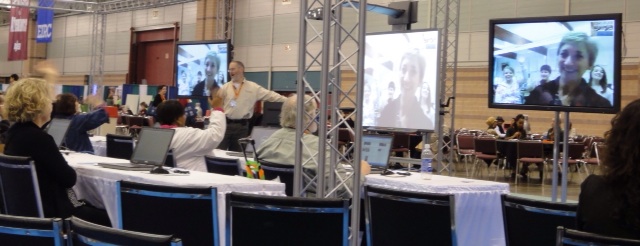Unlike many, I do not have Twitter open all the time. In fact, it’s rarely just open. But every once in a while, I’ll follow it for a time, usually tweeting out a lot of replies which make little sense to most who follow me.
But the other morning, while deciding what I wanted to do first at my desk, I watched and registered a string of posts from CoolCatTeacher, Vicki Davis. She was sharing what appeared to be quotes out of a presentation that she was watching, most of it attributed to a Bob Wise. I twitted back asking who Bob Wise was, and from her reply and a little research I learned that he is a former governor of West Virginia, who, with Jeb Bush (former governor of Florida), has formed the Digital Learning Council (a G-search revealed a lot of blog announcements and press releases, but no URL). Here is a link to one blog posting of the August 18 press release.
Here are some of the tweets that Vicki passed through, along with my comments.
Bob Wise – We have 3 crises “declining fiscal state revenues, mounting teacher shortages, increased global demand for skilled workforce”
These are all monumental challenges to schools, school administrations, and school governance. But I would add that there are also three crises that are (should be) challenging curriculum and pedagogy — that we are (1) preparing a new generation of learners, (2) within a new information environment, (3) for a future we can not clearly describe.
Fy 2010 had the most significant challenges for state budget planning since the great depression. Budget shortfalls everywhere. Bob Wise
Not much I can say here except that we asked for it. It seems to me that these financial crises are not merely weather patterns that we are forced to hunker down and wait out. We are in these financial straits because of the decisions and actions that greedy compassionless people were allowed to make without checks.
I’ll also maintain that we might, during this times of forced reflection, discover that we might be able to conduct relevant education more cheaply by going digital and network, than by continuing to rely pulpwood, fossil fuels, and serving time in schools.
“Education ranks 55th out of 55 industries surveyed in the US” in the use of technology. Bob Wise about 3 hours ago
 |
|
It’s a powerful video, owing in no small part to the people who are sharing their insights. I’m looking forward to working with Stephen Heppell again in February.
|
I’ve seen and heard this one before — the first time in the effective and inspiring Pearson Foundation funded video, Learning to Change/Changing to Learn. I do not recall who used the quote, only that it struck me on an emotional level and I wanted to find the source — which was not provided by the video as I recall.
I discovered a report, Digital Economy 2002, published by the U.S. Department of Commerce that listed 55 U.S. industries ranking them by their utilization of information technologies. The table on page 35 is labeled “IT-INTENSITY RANKING BY RATIO OF INDIVIDUAL INDUSTRY ITEQ/FTE TO OVERALL ITEQ/FTE, 1996 AND CUMULATIVE SUM OF AVERAGE SHARES OF NOMINAL GDP, 1989-2000. As near as I can ascertain, ITEQ is “IT Equipment” and FTE is “full time employees.”
Although education remains shamefully behind the changing conditions that are defining our world and the future of our children, I have to question this particular angle of argument. The statement is made that education rests behind coal mining on the list, but I have to admit that I would hope that coal miners are entering those tunnels with the aid of the very best information that can be tweaked out by the very latest and most sophisticated information and communication technologies. I do not put education beneath any of these industries in their importance to society. But comparing in a straight line what teachers do, with the functions of mining and manufacturing, dishonors all educators.
“One third of our teachers are eligible to retire in the next 5 years. USA ” 43% of Georgia teAchers are 50 years or older. Bob Wise
Now this is scary, not so much because of the critical shortage of good teachers that will surely continue to plague us. Vision and courage can solve that problem. What worries me is the loss of experience and history, and the growing percentage of classroom teachers who have only known an institution defined and driven by high stakes testing. Even though I know many talented and dedicated young teachers, I fear that teacher-philosophers (with the space to explore, take risks, and innovate) are being replaced by teacher-technicians (who spend their time and talent checking off standards and following pacing guides).
“Almost half of new teachers today won’t be teaching in 5 years.” bob wise
Huge and shocking problem that is perhaps related to our shameful dropout problem. Fix it! Figure out how to keep good teachers and all children engaged in formal teaching and learning and do it. In my opinion it has more to do with a job experience and environment that boldly fosters success, than it does with pay. But teachers do need to be able to live a teacher’s lifestyle.
Georgia has 440 high schools and 88 certified physics teachers. How can we spread this expertise? Bob Wise
This is the quote that sparked my attention and said to me, “You need to think about this, so you should blog it!”
I know that I seem to look at things from an angle that is left of center and often off-kilter — having to spend a lot of time explaining myself. I was shocked by this finding, but not so impressed by Wise’s spoken challenge, “How can we spread this expertise?”
Maybe I’m wrong, but it seems so piercingly obvious to me that adapting to rapidly changing conditions desperately depends on how well you can learn, and not so much on what you’ve been taught by experts — that developing your own evolving sense of expertise is a skill that we need to provoke in our learners instead of worrying solely on who’s going to teach physics to our children.
I would propose that any learner who is ready to take high school physics, should, with guidance, be able to teach it to themselves. This is about literacy. It’s learning literacy.
1973 32% of all jobs could be done by high school dropouts 40% high school diploma. 2007 11% dropouts 34% high school. Bob Wise
coolcatteacher “By 2018 62% of jobs will be done by college graduates or higher.” Bob Wise wake up!!!
This on leaves me unimpressed as well, if only because we are looking at this through lenses that were fashioned over the past several decades. We do not know how our children will work, provide, contribute, govern, and seek self-fullfilment. We do not know what they will need to know or know how to do. We do not even know what shape higher education will take or K-12 for that matter by 2018.
I am all for shock treatment when trying to inspire a willingness to consider and explore change. But the point is to provoke the conversations that bring focus the vision and fit it into the evolving mechanism.
– Posted using BlogPress from my iPad

 The recession continues! But evidence mounts that the world that emerges out the other end will be different from the one that entered it (and hopefully from the one that caused it). My latest indication is what data about Black Friday (2010) tells us. I initially found access to the data in this Mashup blog entry (Black Friday Sales Figures Soar for Online Retailers), by Jolie O’Dell. According to the story and this Coremetrics posting, online sales on November 26 exceeded sales from FB a year ago by 15.9% and the price of the average purchase rose from $170 to $190.30 — an increase of 12.1%.
The recession continues! But evidence mounts that the world that emerges out the other end will be different from the one that entered it (and hopefully from the one that caused it). My latest indication is what data about Black Friday (2010) tells us. I initially found access to the data in this Mashup blog entry (Black Friday Sales Figures Soar for Online Retailers), by Jolie O’Dell. According to the story and this Coremetrics posting, online sales on November 26 exceeded sales from FB a year ago by 15.9% and the price of the average purchase rose from $170 to $190.30 — an increase of 12.1%.

 While I was still in undergraduate school I took a year off. There were lots of reasons, but chief among them was a perceived need for learning that could not be defined in a syllabus or described in a textbook or by an instructor. I’d had enough book-learning for a while.
While I was still in undergraduate school I took a year off. There were lots of reasons, but chief among them was a perceived need for learning that could not be defined in a syllabus or described in a textbook or by an instructor. I’d had enough book-learning for a while.




 It was me and
It was me and  First of all, I don’t like stools that do not allow me to put both feet on the ground. And secondly, there isn’t a phone booth on the planet that Jakes and I can fit in together.
First of all, I don’t like stools that do not allow me to put both feet on the ground. And secondly, there isn’t a phone booth on the planet that Jakes and I can fit in together.

